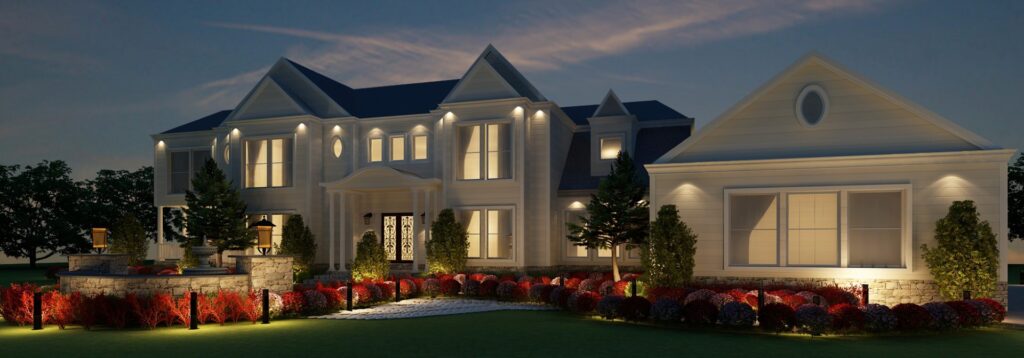Brightening any buildings during night time and showing off its features
Landscape lighting is used to illuminate aspects of a building’s exterior and surrounding gardening during nighttime.


Most modern landscape lighting is low voltage, which is safer and less costly to install.
Although low-voltage lights, operating at 12 volts, receive one-tenth the voltage that a 120-volt system would, landscape lighting does not always require powerful light sources to achieve the goal effect.
Landscape lighting systems are relatively easy to implement, and can be safely achieved by a homeowner without professional help.
However, if a homeowner would like to achieve a specific aesthetic design rather than just a functional lighting source, professional landscape lighting specialists will be most familiar with the various lighting options and ways to arrange them.
Types of Landscape Lighting Fixtures.
There are infinite designs of landscape lighting fixtures. However, there are some commonly used shapes and functional designs in landscape lighting:
Garden – Garden lights sit like a canopy and shine the light downwards, 18-24” off the ground. These lights may highlight flowers or function to light up a walkway. Unlike some other landscape lighting fixtures, the hardware of garden lights are on display.
Wash – Like their name may suggest, wash lights bring a wash of light onto the side of a building or wall. The light is soft, and is diffused across a wide surface.
Bullet – Contrary to wash lights, bullet lights are concentrated on a small surface area on the side of a building or wall. These lights are well-suited to highlight architectural features, trees, or garden structures.
Well – Well lights project upwards from a buried position in the ground, and the majority of the hardware remains unseen. Well lights are best used to highlight the underside of plants, or the base of a facade.
Downlight – Downlights are often located in a high position on a tree trunk or branch, looking downwards. This light creates a moonlit effect, and the curved hardware eliminates side glare.
Flood – Flood lights cast a wide beam (often 40 degrees or more), but is brighter than a wash light. Flood lights light up tall trees of wall facades well.
Components of a Modern Landscape Lighting System.
Landscape lighting typically relies on second-hand power from the main building.
In the light fixture, there is a transformer, bulb, fixture hardware, stake, and cable. The transformer reduces the 120 volt current coming from the household or building to 12 volts before sending the current through the cable to power the light fixture and bulb.
The hardware protects the bulb from the elements, including wind and rain, as well as guides the direction and shape of the light beam.
The type of bulb used in each light fixture determines color, brightness, beam width, and electricity usage, among many other factors that can change the landscape lighting effect.
Finally, the stake keeps the lighting fixture safely placed in the ground.
Cost and Maintenance of Landscape Lighting
Individual landscape lighting fixtures can start at $20.
To power the lighting fixtures, transformers can run around $200, and cables may cost around 70 cents per foot.
Professional installment can cost $2,000 to $2,500 or more, depending on the intricacy and complexity of the design.
Landscape lighting is generally easy maintenance.
However, homeowners should make sure to remove leaves and debris from bulbs, in order to prevent overheating and potential fires.
Burned-out bulbs should be promptly replaced in order to prevent voltage overloads.
♥ Facebook https://www.facebook.com/Editedart
♥ Instagram https://www.instagram.com/m.muhyuddin
♥ Portfolio https://www.behance.net/muhyuddin
♥ Pinterest https://www.pinterest.com/mmuhyuddin
♥ Youtube https://www.youtube.com/c/ArMuhyuddin
♥ Mail ID muhammadmuhyuddin@gmail.com
Related Hashtags:
landscape photography #architecture #lightroom landscape #landscape editing #how to design the perfect landscape #landscape photography post processing #landscape design #how to design your landscape #landscape design 101 #fine art landscape #landscape light #how to design an isometric #night photography #gravit for isometric design #isometric design illustrator #isometric house design #landscape #isometric design #designing your landscape #isometric design tutorial
